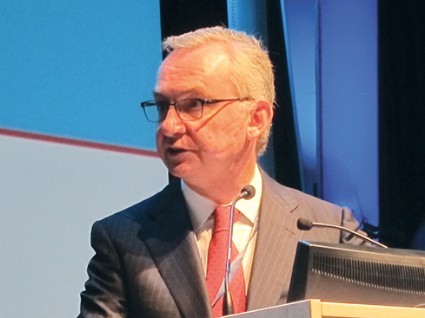User login
AMSTERDAM – PIK3CA mutations were associated with lower pathologic complete responses in women with human epidermal growth factor receptor 2 breast cancer treated with neoadjuvant anti-HER2 therapy in the phase III NeoALTTO trial.
"The lower pCR rate in PIK3CA-mutant tumors is observed in all treatment arms, irrespective of estrogen receptor status," Dr. José Baselga said at the European multidisciplinary European cancer congresses.
Earlier results from NeoALTTO (Neoadjuvant Lapatinib and/or Trastuzumab Treatment Optimization) showed that dual HER2 blockade with trastuzumab (Herceptin) and lapatinib (Tykerb) nearly doubled the pCR rate compared with single-agent trastuzumab or lapatinib (51.3% vs. 29.5% vs. 24.7%; P = .0001).
For the analysis, the investigators performed mutational analyses on tumor samples from 355 (78%) of the 455 study participants. Of these, 23% had a PIK3CA mutation, which is highly consistent with other published analyses, said Dr. Baselga, physician-in-chief at Memorial Sloan-Kettering Cancer Center, in New York City.
No BRAF mutations were found, and one patient had a KRAS mutation.
Overall, pCRs occurred in 21% of PIK3CA mutant tumors and 34% of PIK3CA wildtype tumors (P = .03), he said.
The pCR rate was 28.6% in women with a PIK3CA mutation and 55.8% in those without it in the combination trastuzumab/lapatinib arm, 14.8% vs. 20.4% in the lapatinib arm, and 20% vs. 28.4% in the trastuzumab arm. The difference was statistically significant only for the combination arm (P = .012), but Dr. Baselga urged caution in interpreting this because of the small patient numbers.
PIK3CA mutations were also associated with lower pCR rates in both estrogen receptor (ER)–positive (5% vs. 31%) and ER-negative (11% vs. 61%) patients.
In all, PIK3CA mutations were found in 23% of 124 women in the lapatinib arm, 19% of 112 in the trastuzumab arm, 25% of 119 in the combination arm, 23% of 169 ER-positive patients, and 22% of 186 ER-negative patients.
In a logistic regression model that adjusted for treatment arm and ER status, a significant difference was observed in pCR between PIK3CA mutant and wildtype tumors (odds ratio, 0.45; P = .015), by treatment arm (lapatinib vs. trastuzumab: OR, 0.67; P less than .0001 and combination vs. trastuzumab: OR, 2.97; P less than .0001), and by ER status (negative vs. positive: OR, 2.44; P = .0005).
The findings are concordant with two metastatic breast cancer studies, Dr. Baselga said. In the CLEOPATRA trial, women with PIK3CA-mutant tumors had less benefit from first-line trastuzumab with or without pertuzumab (Perjeta), as did those treated with lapatinib plus capecitabine (Xeloda) in the EMILIA trial.
In the FinHER trial, however, PIK3CA mutations were not predictive of resistance to trastuzumab, he said.
"These findings will lead us to analyze carefully PIK3CA mutation status in adjuvant HER2-positive studies. In this setting, PIK3CA status might be both prognostic and predictive," Dr. Baselga concluded.
Invited discussant Prof. Sibylle Loibl, leader of the medicine and research department, University of Frankfurt (Germany)and member of the German Breast Group, observed that ER-positive PIK3CA-mutant tumors achieved the lowest pCR rate of any group in the current analysis and in the NeoSphere trial of pertuzumab/trastuzumab in treatment-naive HER2-positive breast cancer. "This suggests an interaction of the different pathways and a need to better select the HER2-positive patients," she said.
GlaxoSmithKline sponsored the trial. Dr. Baselga reported no relevant financial disclosures.
AMSTERDAM – PIK3CA mutations were associated with lower pathologic complete responses in women with human epidermal growth factor receptor 2 breast cancer treated with neoadjuvant anti-HER2 therapy in the phase III NeoALTTO trial.
"The lower pCR rate in PIK3CA-mutant tumors is observed in all treatment arms, irrespective of estrogen receptor status," Dr. José Baselga said at the European multidisciplinary European cancer congresses.
Earlier results from NeoALTTO (Neoadjuvant Lapatinib and/or Trastuzumab Treatment Optimization) showed that dual HER2 blockade with trastuzumab (Herceptin) and lapatinib (Tykerb) nearly doubled the pCR rate compared with single-agent trastuzumab or lapatinib (51.3% vs. 29.5% vs. 24.7%; P = .0001).
For the analysis, the investigators performed mutational analyses on tumor samples from 355 (78%) of the 455 study participants. Of these, 23% had a PIK3CA mutation, which is highly consistent with other published analyses, said Dr. Baselga, physician-in-chief at Memorial Sloan-Kettering Cancer Center, in New York City.
No BRAF mutations were found, and one patient had a KRAS mutation.
Overall, pCRs occurred in 21% of PIK3CA mutant tumors and 34% of PIK3CA wildtype tumors (P = .03), he said.
The pCR rate was 28.6% in women with a PIK3CA mutation and 55.8% in those without it in the combination trastuzumab/lapatinib arm, 14.8% vs. 20.4% in the lapatinib arm, and 20% vs. 28.4% in the trastuzumab arm. The difference was statistically significant only for the combination arm (P = .012), but Dr. Baselga urged caution in interpreting this because of the small patient numbers.
PIK3CA mutations were also associated with lower pCR rates in both estrogen receptor (ER)–positive (5% vs. 31%) and ER-negative (11% vs. 61%) patients.
In all, PIK3CA mutations were found in 23% of 124 women in the lapatinib arm, 19% of 112 in the trastuzumab arm, 25% of 119 in the combination arm, 23% of 169 ER-positive patients, and 22% of 186 ER-negative patients.
In a logistic regression model that adjusted for treatment arm and ER status, a significant difference was observed in pCR between PIK3CA mutant and wildtype tumors (odds ratio, 0.45; P = .015), by treatment arm (lapatinib vs. trastuzumab: OR, 0.67; P less than .0001 and combination vs. trastuzumab: OR, 2.97; P less than .0001), and by ER status (negative vs. positive: OR, 2.44; P = .0005).
The findings are concordant with two metastatic breast cancer studies, Dr. Baselga said. In the CLEOPATRA trial, women with PIK3CA-mutant tumors had less benefit from first-line trastuzumab with or without pertuzumab (Perjeta), as did those treated with lapatinib plus capecitabine (Xeloda) in the EMILIA trial.
In the FinHER trial, however, PIK3CA mutations were not predictive of resistance to trastuzumab, he said.
"These findings will lead us to analyze carefully PIK3CA mutation status in adjuvant HER2-positive studies. In this setting, PIK3CA status might be both prognostic and predictive," Dr. Baselga concluded.
Invited discussant Prof. Sibylle Loibl, leader of the medicine and research department, University of Frankfurt (Germany)and member of the German Breast Group, observed that ER-positive PIK3CA-mutant tumors achieved the lowest pCR rate of any group in the current analysis and in the NeoSphere trial of pertuzumab/trastuzumab in treatment-naive HER2-positive breast cancer. "This suggests an interaction of the different pathways and a need to better select the HER2-positive patients," she said.
GlaxoSmithKline sponsored the trial. Dr. Baselga reported no relevant financial disclosures.
AMSTERDAM – PIK3CA mutations were associated with lower pathologic complete responses in women with human epidermal growth factor receptor 2 breast cancer treated with neoadjuvant anti-HER2 therapy in the phase III NeoALTTO trial.
"The lower pCR rate in PIK3CA-mutant tumors is observed in all treatment arms, irrespective of estrogen receptor status," Dr. José Baselga said at the European multidisciplinary European cancer congresses.
Earlier results from NeoALTTO (Neoadjuvant Lapatinib and/or Trastuzumab Treatment Optimization) showed that dual HER2 blockade with trastuzumab (Herceptin) and lapatinib (Tykerb) nearly doubled the pCR rate compared with single-agent trastuzumab or lapatinib (51.3% vs. 29.5% vs. 24.7%; P = .0001).
For the analysis, the investigators performed mutational analyses on tumor samples from 355 (78%) of the 455 study participants. Of these, 23% had a PIK3CA mutation, which is highly consistent with other published analyses, said Dr. Baselga, physician-in-chief at Memorial Sloan-Kettering Cancer Center, in New York City.
No BRAF mutations were found, and one patient had a KRAS mutation.
Overall, pCRs occurred in 21% of PIK3CA mutant tumors and 34% of PIK3CA wildtype tumors (P = .03), he said.
The pCR rate was 28.6% in women with a PIK3CA mutation and 55.8% in those without it in the combination trastuzumab/lapatinib arm, 14.8% vs. 20.4% in the lapatinib arm, and 20% vs. 28.4% in the trastuzumab arm. The difference was statistically significant only for the combination arm (P = .012), but Dr. Baselga urged caution in interpreting this because of the small patient numbers.
PIK3CA mutations were also associated with lower pCR rates in both estrogen receptor (ER)–positive (5% vs. 31%) and ER-negative (11% vs. 61%) patients.
In all, PIK3CA mutations were found in 23% of 124 women in the lapatinib arm, 19% of 112 in the trastuzumab arm, 25% of 119 in the combination arm, 23% of 169 ER-positive patients, and 22% of 186 ER-negative patients.
In a logistic regression model that adjusted for treatment arm and ER status, a significant difference was observed in pCR between PIK3CA mutant and wildtype tumors (odds ratio, 0.45; P = .015), by treatment arm (lapatinib vs. trastuzumab: OR, 0.67; P less than .0001 and combination vs. trastuzumab: OR, 2.97; P less than .0001), and by ER status (negative vs. positive: OR, 2.44; P = .0005).
The findings are concordant with two metastatic breast cancer studies, Dr. Baselga said. In the CLEOPATRA trial, women with PIK3CA-mutant tumors had less benefit from first-line trastuzumab with or without pertuzumab (Perjeta), as did those treated with lapatinib plus capecitabine (Xeloda) in the EMILIA trial.
In the FinHER trial, however, PIK3CA mutations were not predictive of resistance to trastuzumab, he said.
"These findings will lead us to analyze carefully PIK3CA mutation status in adjuvant HER2-positive studies. In this setting, PIK3CA status might be both prognostic and predictive," Dr. Baselga concluded.
Invited discussant Prof. Sibylle Loibl, leader of the medicine and research department, University of Frankfurt (Germany)and member of the German Breast Group, observed that ER-positive PIK3CA-mutant tumors achieved the lowest pCR rate of any group in the current analysis and in the NeoSphere trial of pertuzumab/trastuzumab in treatment-naive HER2-positive breast cancer. "This suggests an interaction of the different pathways and a need to better select the HER2-positive patients," she said.
GlaxoSmithKline sponsored the trial. Dr. Baselga reported no relevant financial disclosures.
AT THE EUROPEAN CANCER CONGRESS 2013
Major finding: In women treated with trastuzumab plus lapatinib, the pathologic complete response rate was 28.6% with a PIK3CA mutation and 55.8% without (P = .012).
Data source: Molecular profiling of 355 women with HER2-positive breast cancer in the NEOALTTO trial.
Disclosures: GlaxoSmithKline sponsored the trial. Dr. Baselga reported no relevant financial disclosures.

